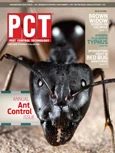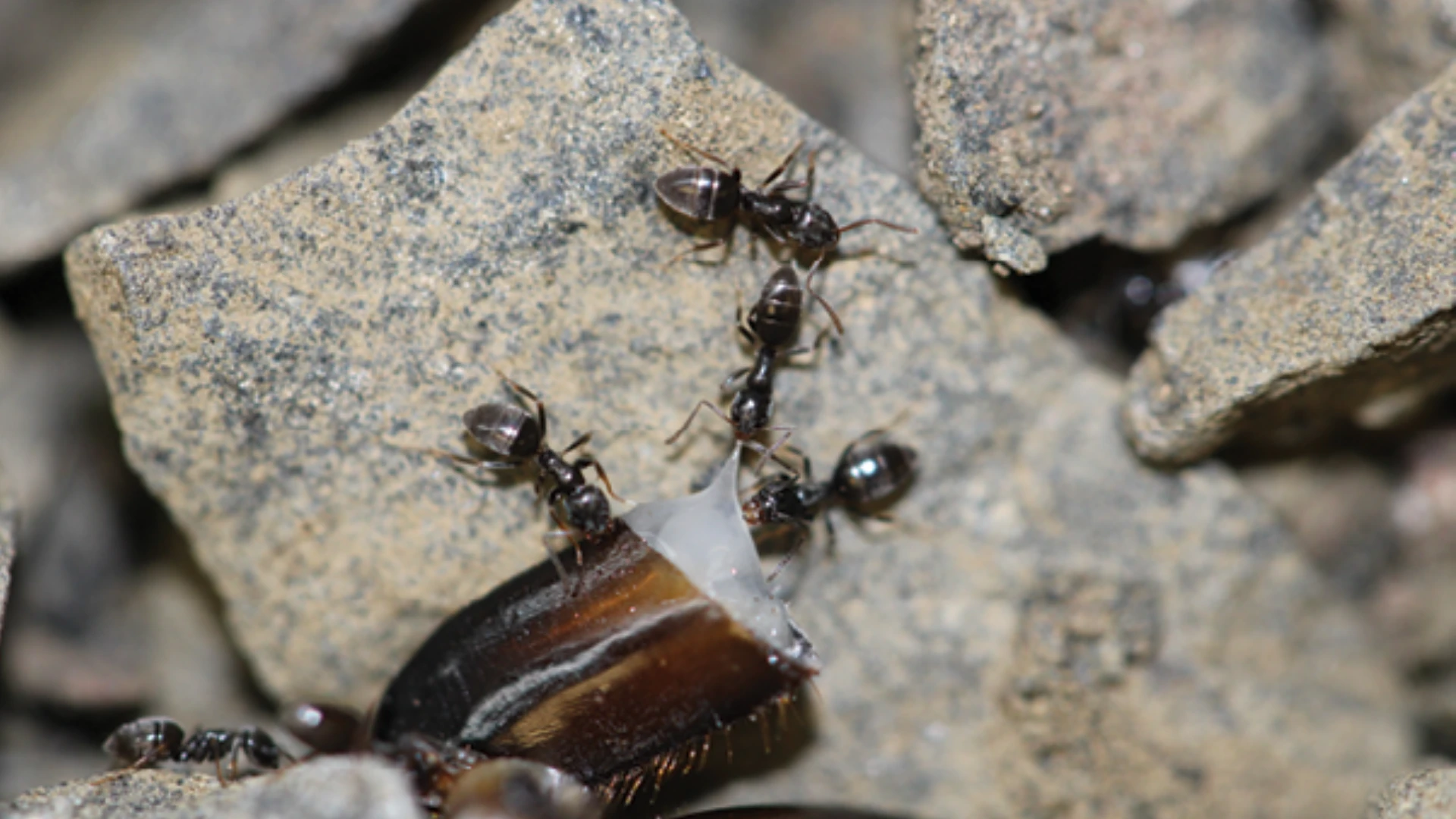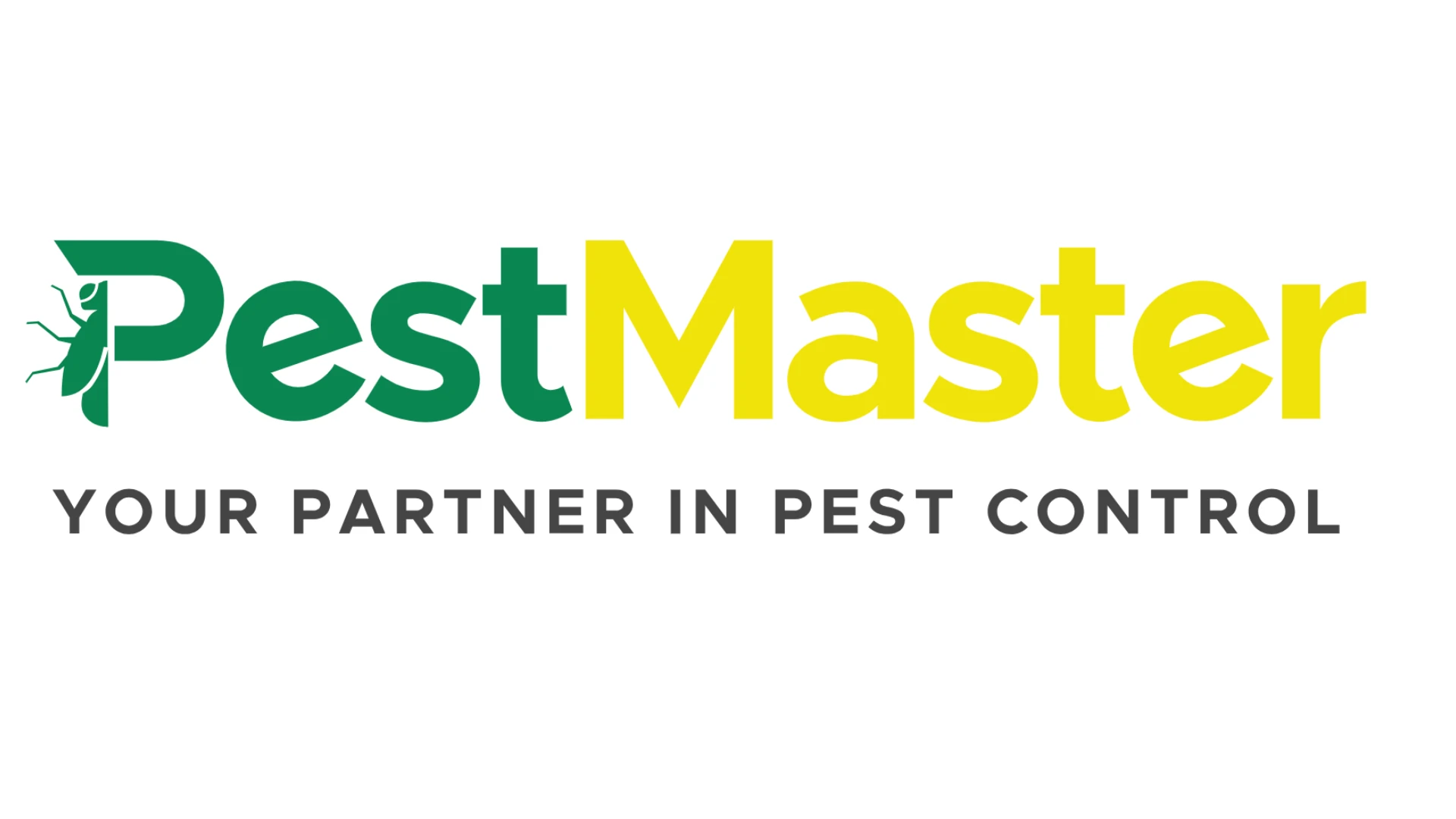Editor’s note: The following article was excerpted from the upcoming third edition of the “Field Guide for the Management of Structure-Infesting Ants” by Stoy Hedges.
The hairy crazy ant, Paratrechina pubens, is sometimes called the Caribbean crazy ant, but the term “hairy” was deemed more descriptive. This species is easily distinguished from its cousins, the crazy ant, P. paratrechina, and the robust crazy ant, P. bourbonica, by the golden to reddish brown color of its body. This species is about 1/8-inch (3 mm) in length, and the body is more robust (not long and thin) in shape than that of the crazy ant. The body is also covered with stout hairs, and the legs and head are not nearly as long in relation to the body as those of the crazy ant. A small circle of hairs is present at the tip of the abdomen. All of the workers are one size.
Each antenna contains 12 segments and has no club. The first antennal segment (the scape) is longer (two times) than the width of the head and it has a number of conspicuous hairs. The scape of the crazy ant’s antenna has no such hairs.
Geographical Distribution. This ant is a major pest in south Florida, particularly the East Coast, and has been found in spots in central and northern Florida, including Jacksonville. It is endemic to several Caribbean islands including Puerto Rico, St. Croix, and Lesser Antilles. The earliest record in Florida is from 1953 in Coral Gables and Miami.
A related crazy ant species, P. guatemalensis, also occurring in South Florida, is similar in appearance to P. pubens, but is noticeably smaller.
In and around Houston, Texas, a very closely related crazy ant has been found and is causing problems for some neighborhoods. Although the taxonomic classification is undecided, the ant is known as Paratrechina sp. near pubens. Under magnification to the untrained eye, this latter species appears essentially identical to P. pubens and its biology and habits appear to be nearly the same.
Key Biology Points. Little is known about the hairy crazy ant other than it is an exotic species that is becoming an increasingly greater problem in south and central Florida. It appears to be associated with disturbed habitats where development has occurred; in other words, where buildings are constructed. Populations have been found thriving naturally in the wild, such as the Florida Everglades.
Colony Structure. Because the biology of this pest ant has not been studied, much of the following information is based on observations and the belief that this species’ biology should be similar to that of the crazy ant.
Colonies have multiple queens (are polygynous), and colonies can be huge, numbering possibly tens of thousands of workers. Huge extended colonies, or “super-colonies,” have been observed around buildings. A single colony consists of a number of satellite colonies connected together by foraging trails. Whether workers from separate colonies are antagonistic to each other is not known, but the presence of huge colonies in some situations suggests that colony integration does occur, although this fact is not proven.
Nesting Habits. This species exhibits the traits of a successful tramp ant as it is opportunistic in its nesting habits and will nest in both moist and relatively dry environments. Colonies are most often found living within soil and objects in contact with the soil. Next to buildings, subcolonies can be uncovered under sod and in mulch and leaf litter. Nests may also occur in tree holes, under loose tree bark, and in other depressions or hollows in plants.
Foraging Behavior. Infestations of the hairy crazy ant often originate off the property being invaded. Commonly, the home plagued by this pest backs up to a field or wooded area, and trails enter the yard beneath the grass, popping up at numerous points around the structure. This species forages both during the day and at night in strong foraging trails that follow structural guidelines over much of their trails. Workers maintain contact with edges of sidewalks, edges of bricks on buildings, ledges, and corners of soffits. Foragers will move onto buildings from tree and shrub limbs that brush against the walls or roof.
Feeding Habits. It is believed that the food habits of this ant are similar to those of crazy ants. They are likely omnivorous and feed on a wide variety of foods, including other insects, grease, and sweets. Small insects and injured large insects succumb quickly to aggressive attacks by foraging workers. The workers also tend homopterous insects (aphids, mealybugs, and scales) to feed on the “honeydew” these insects produce.
Colony Propagation. Each colony contains multiple queens. The colony is mobile and will move from one site to a new site if conditions become unfavorable. While winged reproductives occur in the colony, it appears that “budding” is the likely method of colony propagation. Budding involves one or more queens and a group of workers splitting away from a colony to form a new colony.
*******
Controlling Ants Systemically
There’s another tool available to pest management professionals performing IPM for perimeter ant control.
But perhaps its most interesting feature is that Optigard Flex may be applied to trees and shrubs to control honeydew-producing insects that ants use as a primary food source. When Optigard Flex is applied around a perimeter it does more than create a non-repellent border protecting the area from ants, Syngenta reports.
“One of the most differentiating features of Optigard Flex among non-repellents is its systemic activity in plants. When applied as a soil drench, the active ingredient (thiamethoxam) is absorbed by the plant’s roots and works its way up to the leaves,” said Dr. Bob Cartwright, technical manager for Syngenta Professional Products. “When applied as a foliar spray, the active ingredient translocates throughout the canopy to protect against homopterous insects.
“This systemic action helps eliminate honeydew-producing insects like aphids, whiteflies, scales and mealybugs. These plant-sucking pests produce large quantities of honeydew, a sugary excretion that serves as a food source for ants. Optigard is the only non-repellent product that provides such a high level of systemic action.”
In general, ants are around a customer’s home because they are feeding, so cutting off their food source reduces the pressure.
“If you look at any of the literature, for almost every ant, honeydew comes up as a major part of their diet. That concept is what we were going on — reducing the food source,” Cartwright said. “We often can’t do anything about moisture problems and shelter is there all the time. Food is the one thing from a control standpoint that is easier to fix than the other things.”
One of the key points when using the product is explaining to the customer how the product works. The customer may see dead aphids within a day or two of treatment but not see fewer ants. “That’s where a technician needs to understand what they’re trying to do,” Cartwright said. “Technicians need to explain that we’re taking the food away and helping to try to starve the colony. They need to explain the long-term benefit and that this is one tool in a complete IPM program.”
For more about Optigard Flex, visit www.syngentapmp.com.
*******
Key Inspection Tips. Outside, trails of hairy crazy ants are generally easy to find being visible on walkways, foundations, and the sides of buildings. Once a trail of ants is found, workers carrying bits of food or whose abdomens appear swollen (often with what appear to be stripes) with food or water will usually be returning to the colony. The trail should be followed in the direction in which these workers are heading.
Inside, these ants may nest in wall voids and in the soil of potted plants and atriums. The workers will forage along baseboards both above and below the edge of carpets.
When this ant is observed foraging indoors, an attempt should be made to follow the trail to the point where the ants enter under a wall or through a crack (e.g., under a doorway). If ants are observed entering under a wall, the foundation and wall outside that area may reveal ants entering from a colony located outdoors.
Contributing Conditions. As with most ants, moisture is a limiting factor in the survival of this ant. It is nearly impossible to significantly impact an infestation of these ants by attempting to limit moisture conditions. If conditions exist which result in excess moisture (e.g., sprinklers which spray onto the foundation), they should be corrected.
Branches of trees and shrubs need to be pruned away from the structure’s roof and walls. As many cracks in the exterior walls as possible should be sealed. If possible, a vegetation-free border should be installed around the base of the foundation to make the area less attractive to ants and to make inspections of the foundation easier. This vegetation-free border should contain gravel or small stones and NOT bark chips or mulch. Mulch and bark chips hold moisture, creating an ideal nesting site for ants.
Items under which these ants could nest should be removed, including boards, bricks, stones and logs. Firewood should be stored off the ground and as far from the structure as possible.
Managing Infestations. This species may well be the most difficult pest ant to control in buildings. Complete elimination of infestations of this species inside structures on a long-term basis is nearly impossible in areas where this ant is well established. When a structure and its surrounding property are serviced to eliminate the existing colonies, new colonies will quickly move in from surrounding properties. More frequent inspections and/or treatments, therefore, are necessary for buildings where hairy crazy ants are involved.
Three steps are needed to control this ant: (1) correcting any conditions contributing to the infestation; (2) locating and treating existing colonies; and (3) targeted treatments with a residual, liquid insecticide to help prevent ants from entering the structure.
A thorough inspection of the property may be made inside and out to identify all possible crazy ant colonies on the property before any treatment is performed. Following are treatment techniques:
Ant colonies living in the soil or under items, such as stones or logs, may be treated by drenching each individual colony with an appropriately labeled residual insecticide using a compressed air sprayer or backpack sprayer. Larger colonies will require a greater volume of insecticide. Raking through the soil with a small hand rake before and after treatment will allow more thorough penetration throughout the colony.
Numerous ant colonies living in mulch in landscaping beds can be treated by drenching with an appropriately labeled residual insecticide using a backpack sprayer or a truck-mounted power treating unit set at a low pressure. The mulch should be raked back to expose the colonies, the colonies drenched thoroughly, and the surface treated after the mulch has been raked back into place.
Perimeter treatments using nonrepellent formulations applied as a barrier treatment around the perimeter have demonstrated the ability to depress the colony population to the extent that indoor sightings of ants greatly diminish and even disappear. With hairy crazy ants, however, the populations can be so large that foraging workers can actually wear trails through nonrepellent barriers to the point that no effective residual remains. In such cases, ants reinvade the structure, and repeat treatments are commonly required. It is not uncommon for homeowners to clean up thousands of dead workers daily only to see live workers continue to enter (see photo on page 58). Such activity can go on for weeks with the dead continuing to pile up while new foragers keep on coming.
Although a perimeter treatment with a nonrepellent product can be beneficial, it is not recommended around buildings as a stand-alone strategy to control the hairy crazy ant. Targeted applications directed at active trails, nest sites, and landscape mulch are considered more effective. The key will always be finding and treating as many nest sites as possible and following up to locate new or overlooked nest sites.
Trails may be treated back to the nest sites or at the perimeter of the property using a water-based residual to kill foragers and deter foraging activity to the building.
Ant baits are not considered effective for hairy crazy ant infestations due to their varied feeding habits. Baiting alone is clearly not an acceptable option for this pest ant, but combining liquid ant baits with above techniques may be helpful. Liquid bait stations may need to be checked as often as weekly when large ant populations are present.

Explore the April 2009 Issue
Check out more from this issue and find your next story to read.
Latest from Pest Control Technology
- Target Specialty Products Expands Sales Leadership Team
- Mosquito Joe Promotes David Price to Vice President of Strategic Growth
- Abell Pest Control Recognized as One of Canada’s Best Workplaces in 2025
- Scorpion Launches Capacity Marketing Engine
- Petti Pest Control Owners Reflect on Finding Success as a Father-Son Duo
- Effective Mitigation of Crow Infestations
- Mosquito Control: Spraying vs. IPM
- Terminix Service's Leaders Inducted into South Carolina Business Hall of Fame





